|
The turn of the year to 2025
brought with it some nice weather but calmer wind conditions. Donít get me
wrong, we had some blustery days, but more calmer days overall.
It was on such days that
whilst I had models to fly in light winds, I wanted something that I could still
chuck around, or something that I could possibly fly from some small sand dune type
hills and have lots of fun.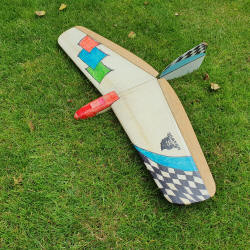
I have seen people flying
Ahiís, a great model, very manoeuvrable, but not sure thatís my bag. I wanted
something that would suit my type of flying, can groove around, but still offer
close-in aeros. I remember having a Dream flight Alula Mk1, a
tailless design, which was good, but it only came out on really calm days, I've
even got a RES model, but again, not exciting to fly and a bit fragile. So many
models are either light conditions or high wind designs, not many are out there,
as far as Iím aware, that covers both in one machine.
Given that I have quite a few
tailless designs to my CV (I like tailless designsÖ..), I set to working out
what would turn my normal design pocket rocket specification into a close-in
aerobatic wing, but one that could still take on a bit of a blustery day.
First off, was deciding on an
aerofoil section that would be suitable. I remembered that a previous DLG model
(Blaster) that I flew, had a really good speed range. It would fly slow but yet
would give a good account of itself when flown in winder conditions especially
if the aerofoil had a little reflex (speed) dialled in on the ailerons. It even
fared well on the slope.
As I didnít want a pocket
rocket, per se, I ruled out some previously aerofoils that Iíve used; MH45, PW51
etc, both very fast, no, I wanted something different to give me a wider speed
range.
Searching my Profili 2
aerofoil library I found a Mark Drela DLG wing section that seemed, visually at
least, partly reflexed. Having quickly looked at the initial data I decided to
send this to my CNC foam cutter and cut a few sample foam ribs.
Feeling that I would probably
need a little more reflex for a tailless design, I then modified the chosen
aerofoil and set an additional reflex of 1.5 degree, which looked about right.
Other considerations was that
of wing sweep. I wanted something manoeuvrable at slower speeds. Forward swept
wings seems to aerodynamically enhance roll control, much like the Dream Flight
Alula. sweep back would make the wing a little more stable and possibly faster.
The first wings was set at
40Ē span (I know, thatís old school, but then I am getting on a bit), ok then,
~1.01m. Well I was using an off-cut of foam, plus my small original Wotzat
design also has a 40Ē span, so I could directly compare this new wing to that of
the Wotzat.
The wing dimensions were
input to the CNC cutter and a set of closed cell foam cores were quickly
created, the wing tips of each panel were shaped to provide a semi elliptical
wing tip. Not only does it make it look aesthetically pleasing it also has the
advantage of reducing tip vortices and thereby, a reduction in drag.
The application of a 6mm hard
balsa root rib through which to provide a hard point for the wing bolts and 12k
carbon tows for the leading edge and Peel Ply for the living hinge. The mylars
were cut and waxed and laid up with a couple of layers of light glass cloth and
epoxy which were assembled on either side of the foam cores and put in the vac bag.
Basically a glass foam glass sandwich.
24hrs later, the panels were
taken out of the vac bag and put in the airing cupboard to keep warm for a
couple of days to continue curing before releasing the mylars from the wing.
The Reveal:
Releasing the mylars was a
pleasure. A nice finish to the wing panels, a light layup, but still quite
strong. The wings were trimmed, round servo holes cut and Elevons released
allowing the Peel Ply to operate as a living hinge.
The panels were joined with a
small amount of dihedral. The join was reinforced with my usual diamond shaped
glass cloth top and bottom. This works well to spread the load and not distract
too much from the wing profile as it can be blended to the aerofoil shape much better than glass
joining tape.
I was not in a position to
make a new lost foam fuselage but had a small balsa fuselage that could be
adapted with a tail boom to get the wing in the air quickly.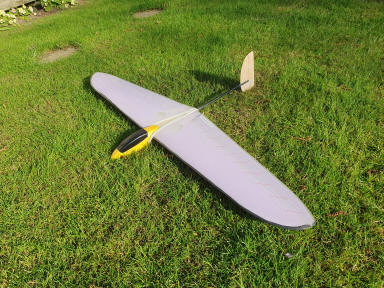
A Balsa fuselage, an 8mm uni-carbon
tube and a 3mm balsa fin joined together easily and provided a fairly attractive
fuselage. I didnít use wing bolts in the end as there was not enough of a
fuselage to install captive nuts so I improvised. A 3mm carbon rod in front of
the wing to which rubber bands could be attached, the other end of the bands
simply slid over the fin and is retained by the tail boom behind the wing. Not
pretty, but it worked!
A 300mAh NiHm battery and
small 4ch receiver and 2 high Tech HS 45 servos - its what I had in my servo box
and had been there for many years, un loved, so they now had a purpose and were
adequate for the job.
The CG was calculated for 17,
18 and 19% of the average chord. I set the cg at 18% with just a small amount of
lead up front with the AUW coming out at 279g (9.8oz) giving a wing loading of
5.8 oz/ft Sq Ė Result! But would it perform in blustery conditions???
1st Flights:
The day of the maiden flight
was a sunny day, Easterly winds, quite calm at my home but once up on the hill
the conditions a little way back from the slope edge were between 8 mph and
14mph, but at the compressive edge of the hill it was gusting to 23mph at times.
The first thing I noticed was
the model needed a little more reflex (up Elevator) to hold level flight given what seemed
like a little nose heavy. I had already set up a number of different throws for
the Elevons through use of a 3 position rate switched, so I quickly found the
right responses.
A quick and uneventful
landing saw me tweaking the CG and trailing edge reflex setting (Up trim) and it was back to the
front of the hill for another launch. This time, the launch was straight and the
model quickly picked up speed. Handling was good, the stall was almost
non-existent, even with full up elevator held in, it just went into a state of
hyper-stalls, (Gently nodding) but when released, the model quickly accelerated
putting in quite a lively performance. It needed a tweak to the Aileron
differential to make the rolls more axial, but otherwise the model seem to have
the good performance that I was hoping for.
Subsequent flights on the day
had me stretching the flight envelope to speed runs, the blustery conditions
didnít affect the model too much, it remained quite stable. Close-in, it was
performing rolls, loops stall turns way back from the edge of the slope, almost
over my head.
Subsequent days of flying the
new model did not disappoint. It worked well in light conditions but retained
its energy when flown with higher wind speed, carving turns saw the model
accelerate in the turns and half pipes providing more height than before on each
side.
Reflection:
The finish of the glass wing
was good, albeit a little fragile, already having a few dimples in the surface
from mishandling during its manufacture.
Reflecting on the first
flights I believe that I had chosen a suitable aerofoil but the trimmed position
of the elevens suggested that additional reflex was needed. A new wing was cut
with a little more reflex, now at 2 degree.
Prototype 2Ö..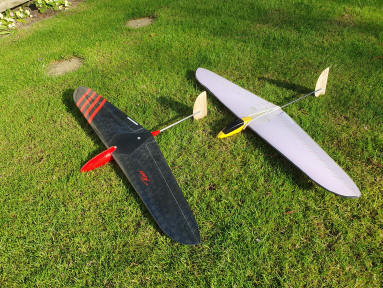
The new wing panels were cut
with the additional reflex, and 88g Spread tow carbon used for the skin which
was underpinned with 49g glass cloth and a fine Kevlar hinge this time.
The wings were joined in the
same way with 10mm of dihedral under each wing tip.
A new fuselage was then
produced using a lost foam technique. This technique requires a foam fuselage
shape to be carved and sanded, then wrapped in glass cloth and epoxy. Once
cured, the foam is removed from inside leaving what is now an epoxy glass
finish.
Installation of an 8mm uni-carbon
tube and a fin that consisted of 3mm balsa with the edges recessed and
carbon tows wrapped around its circumference. Once this was cured, I sanded
a slight symmetrical aerofoil shape feathering onto the carbon edges which was
then glassed and vac bagged with 25g cloth which provided a really nice and
strong finish.
Clearly the fuselage is
heavier than the initial balsa fuz, but this was still a development model. If I
were to mould a fuselage, I am sure I could reduce the fuz weight by at least
30%.
The whole model came out at
398g (14 oz), over 100g heavier than the first model, but it still represented a
fairly good wing loading (9.5oz/ft sq).
The maiden flight of the 2nd
model didnít disappoint. It was a winder day than previous and the model
performed extremely well. Indeed, given the extra weight, it was quick when
pushed, with it quickly gaining speed out of turns.
Feedback:
Iíve let other people fly
these two models and both said they liked its performance and showed some
interest in obtaining one of their own which was encouragingÖ. no pressure
thenÖ.. . Subsequent days out on different slopes have resulted in fellow
modellers discussing its merits behind me while Iíve been flying and plenty of
interest in the model. It does help having the spread tow carbon finish for them
to ogle and drool over Ė yes, bragging rights ÖÖ.
Given that the carbon wing is
a little heavier than the first glass version, I decided to increase the wing
span to 1.2m with a slight change in layup, still finished in spread tow carbon
but with 25g cloth underneath to reduce overall weight. The two panels came out
at just 0.8g difference and once trimmed this was further reduced to 0.4g
difference, with each panel weighing circa 86g apiece.
This new larger wing has also been
married up to the previous lost foam fuselage and its encouraging that even
though itís a larger wing, it came out at a reduced AUW of 7.5oz / ft sq.
Next time I can get out to
fly, hopefully in a few days time, the two different carbon wings and the same
fuselage will allow me to compare performance directly between the two.
Progress: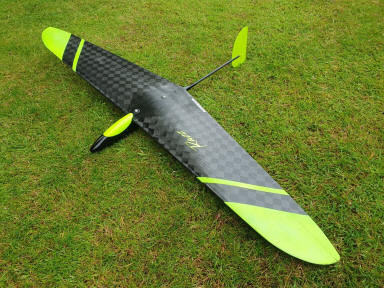 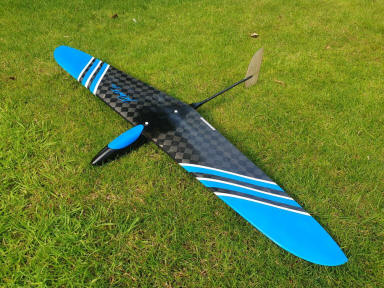
Well, time has now moved on,
with many flights taking place on different slopes with encouraging results. I
had the misfortune of a mid air collision with the new model, the other model
hitting my uni carbon tail boom. It looked as though Iíd got away with little,
if any damage. Well, that was until I pick the model up and twisted the tail.
The whole uni-carbon tail boom had split lengthways but had kept its integrity
to get model down safely.
Trying to drill out the
remnants of the uni-carbon, had me damaging the lost foam fuz, which would have
taken a lot of effort to repair. This did me a huge favour really. I didnít
spend too long coming up with a new fuselage shape fashioned out of block balsa
for the plug for a new fuselage mould.
I've made the mould so as to
use an internal bladder, essentially to inflate a balloon to push the glass and
seams into place during the cure process of each fuselage. This results in a
nicer and consistent finish inside the model. I have used this technique on both
the Wotzat and Hotshot fuselage moulds and it works well resulting in less hassle
when joining the two halves of the fuselage and a better finish.
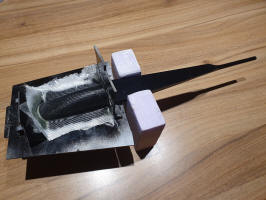
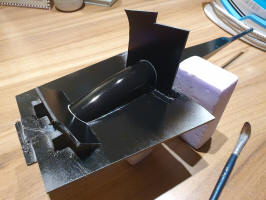
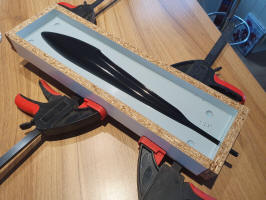 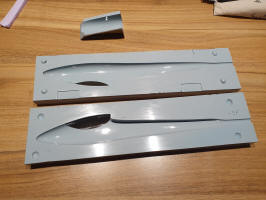
I made the canopy mould
directly from the fuselage plug prior to laying up the actual fuselage mould.
I had also sourced some 8mm
thin walled rolled / woven carbon tube for the tail boom - more resilient and
lighter.
The new fuselage incorporates
a 3d printed internal locator for the tail boom to ensure it aligns perfectly.
The canopy shell is recessed into the fuselage. It uses a 3mm flat carbon
leading edge locator glued into the canopy shell and a small magnet to the rear
to lock it all in place.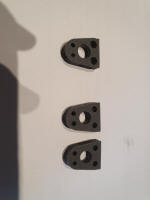 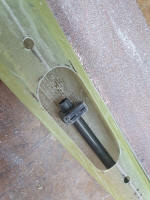
I have now fabricated two
fuselages, one for each carbon wing set. I've even added some fluorescent paint
to the wings to make them stand out better whilst flying.
I fitted a rudder to the 1.2m
wing model which has improved its manoeuvre capability. Applying rudder during
close-in sharp
turns can really get the model turned around quickly with very little
loss in speed.
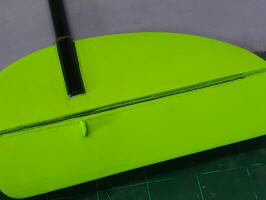 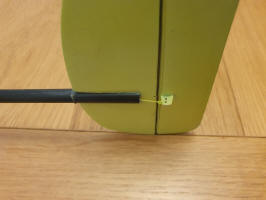 The rudder is controlled by a
single pull wire / string transiting through the tail boom to the rudder
horn. This is made possible by the use of a torque spring fitted to the hinge
line of the rudder. This puts the rudder full throw to one side, the pull from
the servo hold the rudder central, or pulls past centre to fully oppose the
spring, giving full control movement. The rudder is controlled by a
single pull wire / string transiting through the tail boom to the rudder
horn. This is made possible by the use of a torque spring fitted to the hinge
line of the rudder. This puts the rudder full throw to one side, the pull from
the servo hold the rudder central, or pulls past centre to fully oppose the
spring, giving full control movement.
I had to fit very fine brass
tubes into the fin and rudder for the 0.5mm wire torque rod to fit as the thin balsa was
being damaged by the wire. The tubes make it better and allows for the removal
of the spring if necessary. I made a 3d printed rudder servo mount for a small
7g servo that glues to the fuz side wall just inside the canopy hatch. The next
model, I will explore the use of closed loop control or even a small gauge wire
pushrod.
Both models fly well in a
good range of conditions. Indeed I have flown them in a low as 5 mph winds,
albeit I needed to work the wind / hill to keep it going and they have performed
well in wind speeds up to and in excess of 20 mph.
Ballast???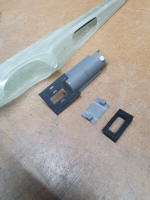 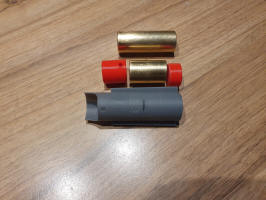 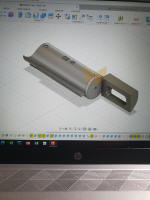
I made a 3d printed ballast
tube to fit to the 1.2m model. I have flown it with both additional 50g and 100g
brass ballast, but to be honest, it just made the model able to penetrate the higher
wind speeds, manoeuvres, were much bigger given the extra weight. but in such conditions close in aeros is probably not recommended.
I've decided that whilst ballast is an option, Iíd rather just limit the model to
flying up to circa 20mph winds, in which it performs very well with no ballast.
Thereafter, I have other models that I would want to fly in more gusty extreme
conditions.
Verdict:
Overall, I am so please with
the new model now named RAZZ (A google search says the definition of RAZZ is ďTo
Tease Ė PlayfullyĒ), which I think is an apt name for a model that evokes a
playful mode of flying.
Having now visited many different slopes and flown the
Razz, I continue to
receive some great encouraging feedback which has resulted in me making a few
Razz models for others to own and play with......
Indeed, their feedback, and I
quote is:
 


|
